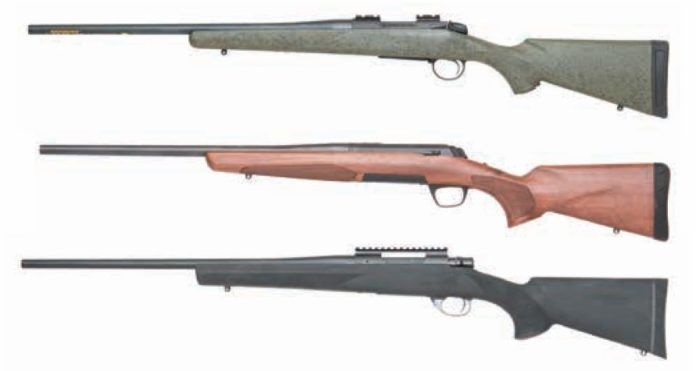In the March 2018 edition of Gun Tests, we evaluated a Browning A-Bolt Micro Hunter in 7mm-08. We gave that rifle two grades: the first was an A- for adults and a C+ for youths. An A- is a good grade for a good firearm, but we also observed that it was “too much rifle and recoil for younger shooters.” We wondered if we went to a smaller caliber in the same format rifle, could that reach an A grade range for a youth shooter? In fact, we wondered about doing that with a number of rifles chambered for the soft-shooting but very accurate 22-250 Remington.
Most parents, coaches, or instructors start young, small-statured, or recoil-sensitive shooters out with smaller chamberings. The vast majority of us probably started out with a 22 LR and progressed from there. Conventional wisdom commonly suggests that a 243 Winchester would make a good transition cartridge to bring the new shooter up to a round with enough energy to properly harvest a deer or similarly-sized animal, and it often does. However, in 10 years as a professional instructor, the writer and lead tester has frequently seen that the 243 produces too much noise and recoil for the inexperienced shooter, at least in the early part of his or her shooting career. What could be better than the 243 Win. for this application? We wondered if a good 22-250, with properly constructed bullets, could serve double duty as a varmint and deer rifle (in those states where the round is legal for deer). If so, such a rifle would make a well-received gift for the recoil-sensitive shooter who is interested in taking his or her first deer.
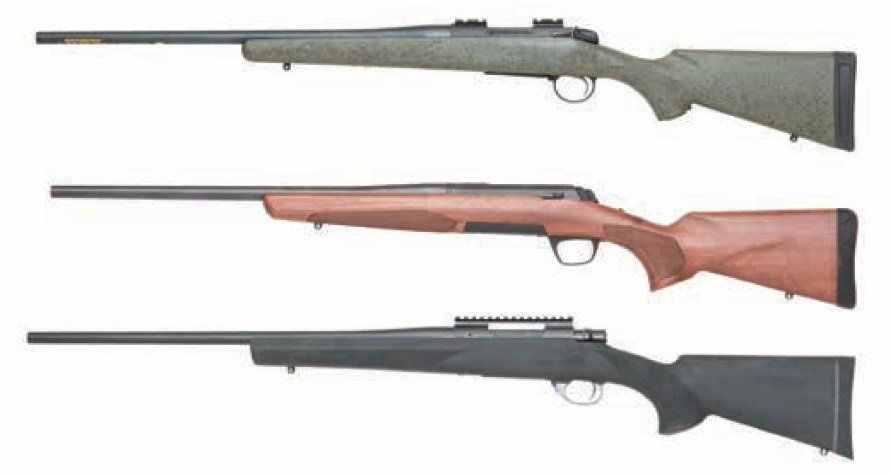
We also recognized that “inexperienced” does not necessarily mean youth or female. Inexperienced shooters come in all shapes and sizes, so our collection of rifles for the test needed to as well. So, in this evaluation, we tested the Howa Model 1500 short action youth model, $529; a Bergara B-14 Hunter short rifle, $825; and a Browning X-bolt Micro Midas, $880. The Browning X-Bolt Micros Midas has a short stock with additional spacers provided. The Howa can be purchased with a youth- or an adult-length stock (we got both), and the Bergara B-14 Hunter comes with a traditional full-length stock.
The Round
The 22-250 Remington is essentially a 250 Savage case necked down to 22 caliber, with the early design work going back to the 1930s. It was legitimized in 1965 when Remington adopted the cartridge as one of the standard loadings for the 700-series rifles. Almost every major rifle manufacturer currently lists models in this chambering. It is fast, easier on barrels and cases than cartridges like the 220 Swift, and accurate enough to be used in some benchrest circles.
One question we asked at the outset, were we asking a 22-250 rifle to do things for which it was not designed? Set up as a varmint rifle, it is most commonly used to take small, thin-skinned animals, a job that it does extremely well. Because the rifle was intended to shoot lightweight bullets, barrel rifling twist was established accordingly. The twist of the rifling in the barrel spins the bullet, making it gyroscopically stabilized – just like an old top. Twist is measured in how many inches of barrel the rifling takes to make one complete revolution. The smaller the numbers, the faster the twist. For example, old 223 Remington rifles were set up with 1-in-10-inch twists (denoted as 1 in 10 or 1:10). That did well with 55-grain bullets. But the heavier (actually, the longer) the bullet is, the faster the twist must be to stabilize that bullet. Most manufacturers now rifle their 223 barrels with at least a 1:9 inch twist and, frequently, with a 1:7 inch twist, allowing them to accurately shoot bullets to 77 grains and, sometimes, even heaver.

For our purposes, many, if not most, 22-250s have the same problem. Twists of 1 in 14 inch and 1 in 12 inch are common in current rifles, and they work extremely well with lightweight varmint bullets. Those same bullets are also generally unacceptable for deer-sized animals. For that, we need heavier bullets, specifically designed for that animal. That also means we need a faster twist to stabilize the bullets. And we want the rifles to still be able to shoot the varmint-weight bullets well. No problem, right? Both of these factors guided our rifle selection as well as the ammunition tested. The Howa, for example, has the traditional 1:12-inch twist, while both the Browning and the Bergara sport 1:9 twists. To see how the various twists handled a range of bullet weights, we tested Black Hills Gold ammunition loaded with 36-grain Varmint Grenade bullets as well as their offering with 50-grain Hornady V-Max bullets. Then we stepped up in weight for three more loads specifically designed to hunt deer-sized animals. Those were the Barnes Vor-TX 50-grain TSX, 55-grain Federal Power-Shok, and 64-grain Winchester PowerPoint.
Last, a good rule of thumb says that, for a projectile to be properly effective on a deer-sized animal, it must deliver at least 1000 foot-pounds of energy at the point of impact. Foot-pounds of energy is a factor of bullet weight and speed. Ballistic coefficient (how streamlined that projectile is) affects how far that bullet maintains its energy. We used the Applied Ballistics Mobile app to compute downrange energy, looking at the maximum distance each rifle can produce the proper energy with each cartridge. For the Browning Micro Midas shooting the Barnes 50-grain Vor-TX, the Federal 55-grain soft point, and the Winchester 64-grain soft point respectively, the effective maximum ranges would be 90, 130, and 125 yards. The yardages for the Howa Model 1500 Youth would be 100, 135, and 155 yards. The yardages would be 105, 135, and 150 with the Bergara B-14 Hunter.
Also, we wanted to compare the rifles at the butt. Our expectations on the foot-pounds of recoil energy of a mid-sized 243 versus a similar rifle in 22-250 were proven out in the shooting. According to a formula from an engineer, our Howa Youth Model 1500, shooting the 64-grain Winchester load, generated 4.282 foot-pounds of recoil energy. A Howa 1500 243 Win. with almost identical weight, shooting a 100-grain bullet, would generate 8.105 foot-pounds of recoil energy. That is still pretty light recoil from the 243, but it is almost double that of the 22-250.
How We Tested
All shooting was done at American Shooting Centers (amshootcenters.com), located in George Bush Park near the western edge of Houston, Texas. This range has rifle positions that allow the shooter to reach out as far as 600 yards, so our testers have a great place to play, learn, and test. Shooting was done in mid-summer in Houston. That means it was hot and humid, so breaks were scheduled accordingly to allow barrels to cool. We shot multiple three-shot groups with each type of ammo in each firearm. Group size, muzzle velocity, and standard deviation, as well as muzzle energy and recoil energy, were tabulated and are found in the article. Please note that three-shot groups are almost guaranteed to be smaller than five-shot groups and our results reflect that.
We went Leupold all the way for optics and mounts, using the company’s Picatinny/slotted rails, 1-inch low rings, and the VX-Freedom 4-12×40 scope ($455). This is a second-focal-plane scope with a 1-inch-tube, clear, crisp glass, and a Tri-Moa reticle. This reticle provides 10 marks on the lower half of the vertical reticle, each subtending 1 minute of angle at 12 power. That should provide plenty of holdover points for a rifle intended for 150-yard-max hunting. The reticle also shows 10 marks to the left and right of the vertical bar, giving the shooter good reference holds for windage. Could any of these rifles do everything? Let’s find out.
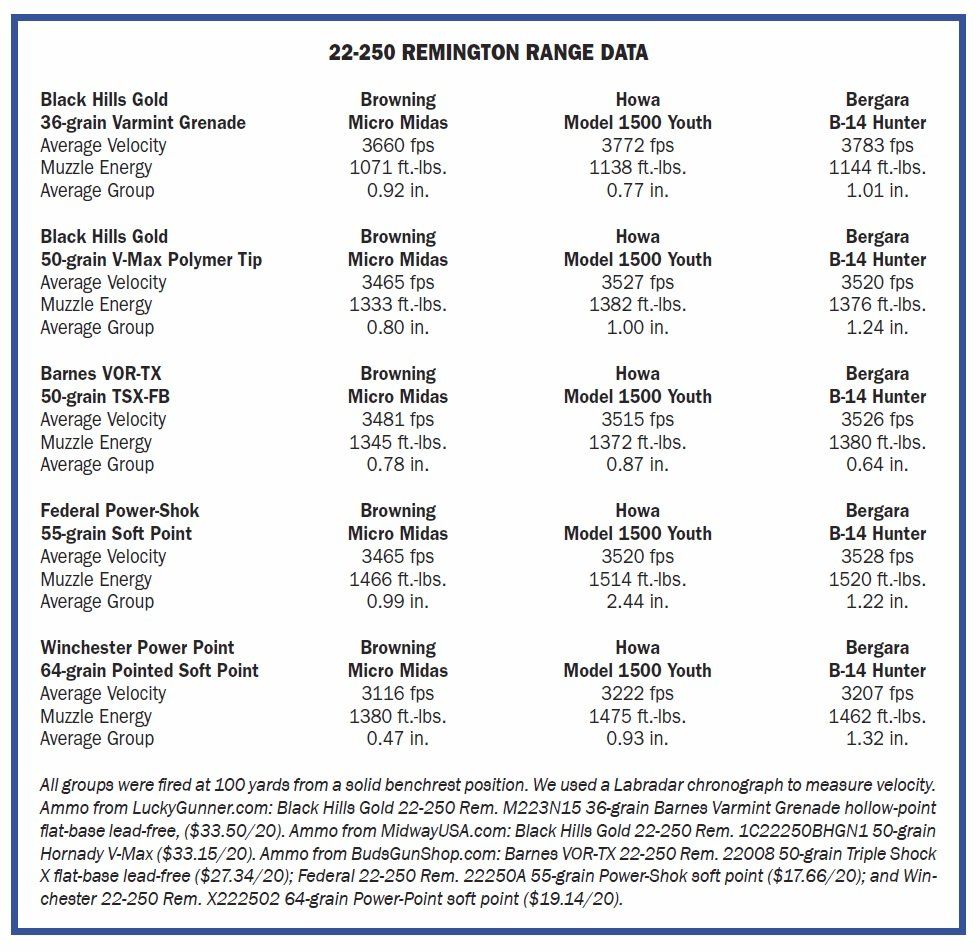
Browning X-Bolt Micro Midas 035346209 22-250 Remington, $879

GUN TESTS GRADE: A (OUR PICK)
Action |
Bolt, matte blued steel |
Overall Length |
38.4 in. |
Overall Height w/o Scope Mount |
5.7 in. |
Weight Unloaded |
6.1 lbs. |
Weight Loaded (64 grain, 5 rounds) |
6.25 lbs. |
Barrel |
20 in. long, 1:9 twist; matte blue steel, free floated, sporter contour |
Magazine Capacity |
4 |
Magazine Type |
Internal, with floorplate |
Stock |
Satin-finished black walnut, bedded, no grip cap, 18-lpi checkering, blued sling swivel studs |
Stock Drop at Comb |
0.7 in. |
Stock Drop at Heel |
0.5 in. |
Stock Buttplate |
Inflex recoil pad |
Stock Length of Pull (no spacers) |
12.5 in. |
Receiver Scope-Base Pattern |
8 screw X-Bolt |
Sight Radius |
NA |
Trigger Pull Weight |
4.75 lbs. |
Safety |
2 position, on tang |
Warranty |
None written |
Telephone |
(800) 333-3288 |
Website |
Browning.com |
Made In |
Japan/USA |
Sometimes, when you opt for a smaller version of an existing platform, you are forced to sacrifice features to save weight or length. Not so with the Browning Micro Midas. This svelte little rifle comes loaded with all of the features found on the full-size X-Bolt, just in a smaller package, weighing only 6.1 pounds unscoped on our scales.
The slightly smaller blued action mounts a 20-inch blued-steel barrel with a 1-in-9-inch twist. In our sample, the barrel was free-floated, at least the thickness of a business card, the full length of the forend, stopping about a half inch in front of the receiver. Most actions have two screw holes for mounting scope bases both in front of and aft of the ejection port. The Micro Midas gives you four in each location. Bases should stay mounted solidly on this rifle. As a side note, our initial information said that on a standard short-action X-Bolt, one-piece bases would work on the Micro Midas, but that was not the case. The screw-hole pattern is the same for both actions, but the Micro Midas is not as long. We solved the problem by buying a two-piece set of bases, $32 (Leupold 65416).
The three-lug bolt has a short 60-degree throw, requiring less movement of the hand to operate and keeping the bolt knob well clear of the scope. It comes with a plunger ejector and a pivoting extractor. The bolt knob has been flattened and angled slightly outboard at the front, allowing the bolt to be easily and quickly worked using the bolt technique our testers favor. The bolt release is a pivoting lever on the left side of the receiver, and the two-position safety is mounted on the tang. Pushing the safety forward unlocks the trigger and the bolt, making them ready for operation. Conversely, moving the safety to the rear locks both systems. There is a compression-type button on top of the bolt handle that, when pushed, allows the bolt to be retracted with the safety engaged. The rotary magazine is made of a composite material and holds four rounds. The magazine dropped freely when it was supposed to and, aided by a well-recessed release, stayed locked up when it was supposed to.
The gold-plated trigger is protected, is made of a matte-finished alloy, and is held in place with two hex-head action screws. The unscoped rifle balances right on the front action screw. The “Feather Trigger” is user adjustable by removing the bottom metal and adjusting a single screw. The stated factory goal is a 4-pound trigger. Ours was a bit heavier than that averaging 4.75 pounds with about 6 ounces of variance. The trigger is adjustable down to as low as 3 pounds. If this were our rifle, we would take it all the way down. That being said, there was virtually no take up required before sear release, almost no overtravel after release, and a very clean, predictable break on compression of the trigger.
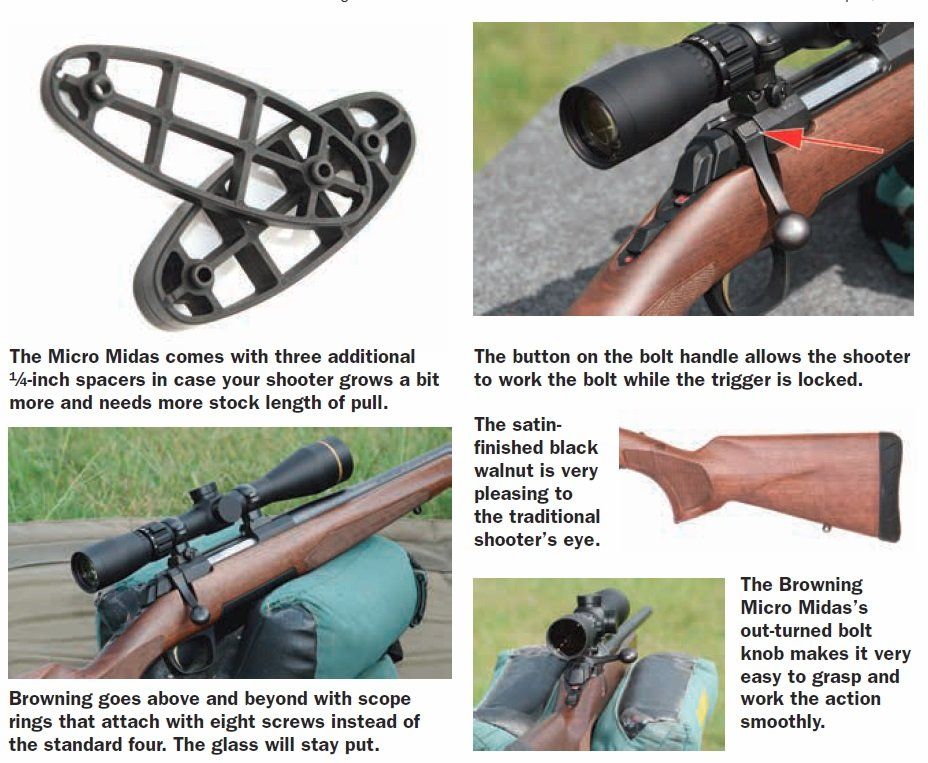
The satin-finished Grade 1 black-walnut stock is very pleasing to our traditionalists’ eyes. The forend is trim for easy carry, and there is a slight swell to the palm. Other than the bolt being right-handed, the stock does not favor a shooter using either hand — both should be able to use this rifle well. The stock sports 18 lines-per-inch cut checkering extending for about 75% of the length of the forend and covering most of the sides of the grip area. We think the well-executed checkering is sharp enough to grant a good purchase on the rifle without being so sharp as to be abrasive. The stock ends with a small Inflex 1-inch-thick recoil pad that is soft enough to aid with the impulse on the already soft-recoiling 22-250. The comb is slanted to move away from the shooter’s face, which helps lessen felt recoil even more. Length of pull is 12.5 inches, great for the smaller-statured shooter. When the shooter grows, three quarter-inch-thick spacers are included, allowing the length of pull to be increased to 13.25 inches. The expected sling swivel studs are included.
We wondered how much energy would be lost with the 20-inch barrel on the Browning Micro Midas versus the 22-inch tubes on the Bergara and the Howa. We weren’t surprised when the muzzle velocities dropped between 30 and 100 fps, depending on the load. Even with the lower velocities, our self-imposed maximum range (requiring a minimum of 1000 foot-pounds of energy at impact distance) did not change much, according to our Applied Ballistics app. This Micro Midas performed flawlessly and shot very well indeed.
The Black Hills 36-grain Varmint Grenade averaged 0.92 inch for three shots, with a smallest group of 0.79 inch. The Black Hills 50-grain V-Max averaged 0.80 inch with a small group of 0.47 inch. The Barnes Vor-TX was even a bit better, averaging 0.78 inch, with a smallest group of 0.45 inch. The Federal 55-grain Soft Point averaged 0.99 inch, with a small group of 0.59 inch. The Winchester 64-grain PowerPoint caused some frustrations for us out of the Bergara, but not here. The average group size was 0.47 inch, with a smallest three-shot group of 0.27 inch.
Our Team Said: All of the rifles shot most of the five different types of ammunition well. The Browning shot them all well. Our testers thought the rifle’s small size, along with the ability to add up to three-quarters of an inch on length of pull would make this rifle an excellent choice for smaller or still-developing shooters.
Howa Model 1500 Youth HGR61203 22-250 Remington, $529

GUN TESTS GRADE: A (BEST BUY)
Action |
Bolt, matte blued steel, two lugs |
Overall Length (Youth stock) |
41.1 in. |
Overall Length (Adult stock) |
42.4 in. |
Barrel |
22 in. long; 1:12 twist, matte-blued steel |
Overall Height w/o Scope Mount |
6.4 in. |
Weight Unloaded |
7.25 lbs. |
Weight Loaded (64 grain, 5+1 rounds) |
7.5 lbs. |
Magazine Capacity |
5 |
Magazine Type |
Internal, with floorplate |
Stock |
Hogue OverMolded synthetic, sling swivel studs |
Stock Drop at Comb |
0.9 in. |
Stock Drop at Heel |
0.8 in. |
Stock Buttplate |
1-in.-thick rubber recoil pad |
Stock Length of Pull |
12.6 in. youth; 13.9 in. adult |
Receiver Scope-Base Pattern |
Howa |
Sight Radius |
NA |
Trigger Pull Weight |
3.3 lbs. |
Safety |
Two-position rocker switch, right side |
Warranty |
None written |
Telephone |
(800) 5-LEGACY |
Website |
LegacySports.com |
Made In |
Japan |
Howa has created a solid rifle, made in Japan and imported by Legacy Sports International of Reno, Nevada. We have used samples of their products many times, as recently as the August 2019 issue, for several reasons: they are frequently a price-competitive brand, they work, and they tend to be very accurate. This rifle was no exception.
Our Howa 1500 Youth Model offered yet another solution for fitting the rifle to a smaller shooter. It came with a youth-sized stock. But there is also a full-sized stock available, for an extra $80, that makes the rifle a perfect fit for dad as well. The Youth Model still ships with a 22-inch matte-blue steel sporter-profile barrel, but the Youth stock takes a full 1.25 inches off the length of pull.
The matte-blue-finished receiver contains a two-lug bolt, also with a matte-blue finish and requires an expected 90 degrees of movement to open the bolt. The bolt is a push feed with a pivoting extractor and plunger ejector. The safety is a two-position rocker switch on the right side of the receiver. Forward is Fire. To the rear is Safe, a position that locks the sear and the bolt. The bolt release is a compression type at the left rear of the receiver. Pushing down on the tab allows the bolt to be retracted from the receiver.
The bottom metal is made of alloy, while the magazine follower is composite, all of which is held in place by two action screws. The floorplate latch is on the forward curve of the trigger guard and concerned us a bit since it protrudes — a little — from the trigger guard, perhaps making it vulnerable to an inadvertent release. We had to work at it, but in a very few of our bumps that could happen naturally in the field, the floorplate came open with less than an intentional action. Still, we did not think that was a highly likely occurrence.
All fives types of ammunition fed perfectly whether from the magazine or just being dropped into the receiver. The curved metal trigger required approximately 0.18 inch before we hit the pressure wall and required less than another 0.125 inch movement to trip the sear and complete its movement. Average pull weight was 3.3 pounds with about 6 ounces of variance. Balance point of the unscoped rifle was right on the front action screw.

This Youth Model comes equipped with a special Hogue stock. These stocks have a rigid fiberglass skeleton that’s OverMolded with synthetic rubber injected at extremely high pressure. This creates a permanent bond between rubber and insert. Add in two bedding pillars to that and the result is a stiff, accurate, free-floating stock on which a shooter can get a solid grip. The comb slants up slightly to the rear. The pistol grip is contoured with a slight swell. Both the pistol grip and the forend have a pebble-grained texture to help with a secure grip. The forend also flattens to a beavertail style to help with bench shooting. The stock is capped by a fairly stiff 1-inch recoil pad. The customary pair of sling-swivel screws are included, with one each mounted in the buttstock and forend.
At the range, we dropped rounds into the action and cycled the bolt. We fed cartridges from the magazine and cycled the bolt. We worked the bolt slowly and we worked the bolt quickly. No matter how we worked it, this Howa rifle fed, shot, and ejected every round.
This rifle has the slowest twist rate of the three tested, so we weren’t surprised when it liked the lighter-weight bullets. The Black Hills 36-grain Varmint Grenade was a clear favorite, with a small three-shot group of 0.53 inch and an average group size of 0.77 inch at 100 rounds. The Black Hills 50-grain V-Max shot a small group of 0.67 inch with an average of 1.00 inch even. The Barnes 50-grain Vor-TX was another favorite with a small group of 0.63 inch and an average of 0.87 inch. Then we moved up in weight to the 55-grain Federal Soft Point, and the groups blew open. Our small group was 2.05 inches, and the average was 2.44 inch. We wondered if the slower twist rate was sufficient to stabilize the heavier bullet. We wondered just long enough to shoot the 64-grain Winchester PowerPoint, and life settled down again. That cartridge shot a small group of 0.76 inch with an average of 0.93 inch.
Our Team Said: We have heard it remarked that rifles are a lot like spouses in that they each have a personality, and you don’t really know what that personality is until you spend some time with them. We found out that this particular rifle just did not like the Federal ammo. The others did. That’s why we test. We were pleased that the standard 1:12 inch twist of the Howa stabilized the 64-grain Winchester load. This rifle would offer outstanding versatility for the family with large and small shooters. Even adding the cost of the second stock, the Howa 1500 still represents an excellent value.
Bergara B-14 Hunter B14S104 22-250 Remington, $879

GUN TESTS GRADE: A
Action |
Bolt, B-14 two-lug system, sliding plate extractor, coned bolt nose and breech |
Overall Length |
41.5 in. |
Barrel |
22 in. long, 1:9 twist, #4 taper |
Overall Height w/o Scope Mount |
6.25 in. |
Weight Unloaded |
7.1 lbs. |
Weight Loaded (64 grain, 4+1 rounds) |
7.25 lbs. |
Action Finish |
Matte blue |
Barrel Finish |
Matte blue |
Magazine Capacity |
5 |
Magazine Type |
Internal with floorplate |
Stock |
Glass-fiber-reinforced polymer with SoftTouch finish; sling swivels |
Stock Drop at Comb |
0.7 in. |
Stock Drop at Heel |
0.75 in. |
Stock Buttplate |
1-in.-thick rubber recoil pad |
Length of Pull |
13.5 in. |
Receiver Scope-Base Pattern |
Remington 700 |
Sight Radius |
NA |
Trigger Pull Weight |
2.1 lbs. |
Safety |
2-position rocker |
Warranty |
Lifetime |
Telephone |
(877) 892-7544 |
Website |
Bergara.online/us/ |
Made In |
U.S.A./Spain |
Starting out in Bergara, Spain, this company has invested decades in learning to build some of the finest barrels in the world. A number of tier-one U.S. manufacturers use Bergara barrels because they are accurate and economical, two words that don’t normally go together. With the B-14 Hunter, a shooter can enjoy one of Bergara’s outstanding barrels mounted in a rifle that, except for the barrel, was manufactured totally in the U.S.
The Bergara B-14 Hunter is the full-sized entrant in this comparison. The matte-blue-steel action mounts a matte-blue-steel 22-inch barrel with a No. 4 contour, a 1:9 twist and a nicely recessed crown. The barrel channel on the stock is tight, but it will allow a standard business card to pass between the barrel and stock as far as the front of the receiver. The bolt has a polished body. It is a standard two-lug system with a coned bolt nose and breech to ensure smooth feeding and extraction of the cartridge. The bolt sports a plunger ejector and what Bergara calls a sliding plate extractor. The safety is a two-position rocker switch on the right side of the receiver. Forward is Fire. The rear position locks the trigger but does not lock the bolt. The bolt release is a pivoting horizontal bar on the left rear of the receiver.
Our testers readily admit to being trigger snobs, and the Bergara trigger was a joy to shoot if you like lighter triggers. There is no take up on the trigger and only a hair over one-eighths inch total travel upon compression. The average amount of pressure required to complete compression averaged 2.125 pounds, with less than an ounce variance. The alloy bottom metal even has a metal follower and an internal box magazine that holds four rounds. Bergara offers different bottom metal that can convert the rifle to a detachable-box magazine. The floorplate release is also on the front of the trigger with this rifle. However, this release is somewhat small and located far enough down the face of the trigger guard that normal bumps and bangs were not releasing the floorplate inadvertently. We had to be very intentional to get the floorplate open. The receiver is drilled and tapped for scope bases using a standard Remington 700 pattern, which is very easy to find.
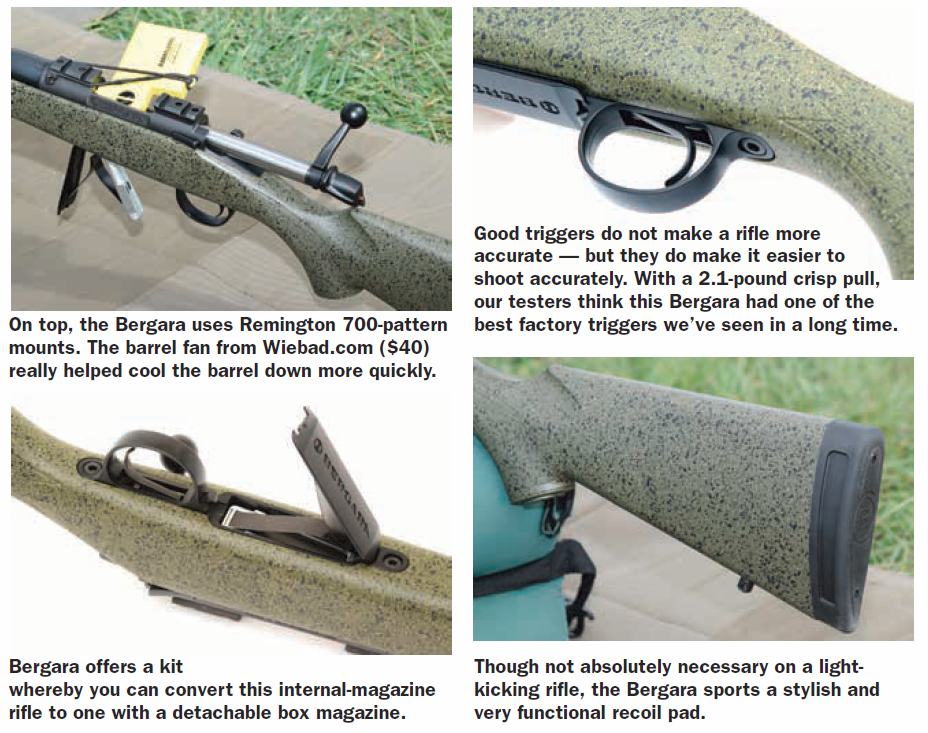
The B-14 Hunter rifle features a molded synthetic stock made of glass-fiber-reinforced polymer. During the molding process, steel pillars are inserted and molded permanently into place, giving the shooter a very stable bedding surface. The base color is green with tan and black specks. The Bergara stock is finished with what they call a SoftTouch coating. It is a slightly softer surface, as the name implies, but still has a bit of a tacky feel to make sure the shooter can easily hold on to the rifle. The stock has pressed checkering on the pistol grip area and about 60% of the forend. Single sling-swivel studs are mounted at the front and the rear. The almost straight-combed stock is capped by a recoil pad about 1 inch thick.
There weren’t any surprises during this shooting session. Our Bergara worked perfectly in feeding, firing, and extracting every round we asked it to. Once again, this is a hunting-weight barrel that can heat up fairly quickly. Groups would start to open up a bit when we let that happen.
The Black Hills 36-grain varmint grenade had an average group size of 1.01 inch with a smallest group of 0.72 inch. The Black Hills 50-grain V-Max averaged 1.24 inch, with a smallest group of 0.98 inch. The Barnes 50-grain Vor-TX offering averaged 0.64 inch with a smallest group of 0.40 inch. The Federal 55-grain soft point also did well, with an average of 1.22 inch and a smallest group of 0.46 inch. That average includes a 2.16-inch group that had two shots touching and a third shot 2 inches away. We didn’t call it a flyer, so we included it. Our challenge turned out to be the Winchester 64-grain soft point. Some of the groups were outstanding, and some not so much. This cartridge had, by far, the largest standard deviation for the muzzle velocities at 41.9 feet per second. Other standard deviations were in the teens and twenties. When we got three shots close together in muzzle velocity, we shot three groups under 0.75 inch. When the velocities spread out, groups enlarged to between 1.5 and 3.25 inches. Still, this load averaged 1.32 inch with a smallest group of 0.56 inch.
Our Team Said: This rifle had consistent accuracy helped by a very good trigger. As with all the rifles tested in this group, felt recoil was very mild. Our testers thought the Bergara would make an outstanding choice as a varmint or close-range deer rifle for the full-sized new shooter.
Written and photographed by Joe Woolley, using evaluations from Gun Teststeam testers.

























